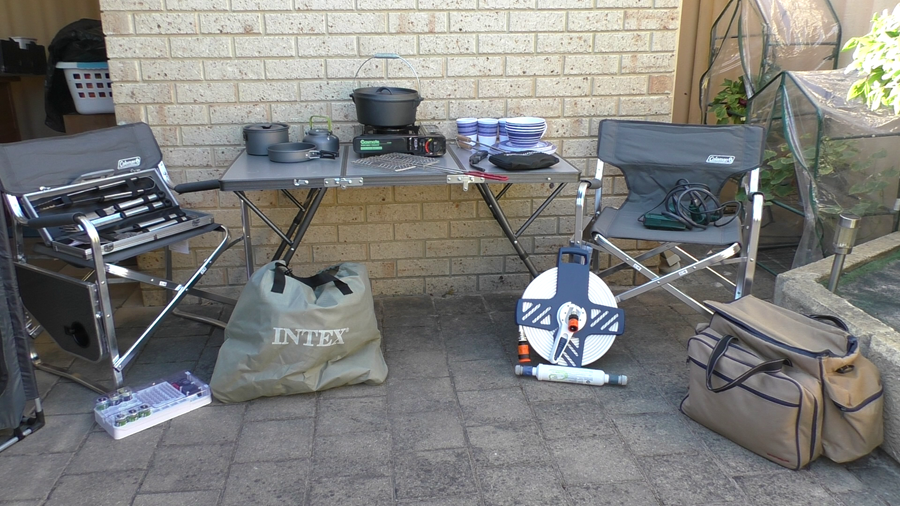Check out our other VIDEOS
NEW **** CLICKABLE VIDEO MAPS **** NEW
POWER


Solar Power system
Price: $ see website
From: OFFROAD Living
RATINGS:
How useful is it: *****
Value for money: ****
Ease of use: *****
How well designed is it: *****
Product quality: Good
Our recommendation: So far we are very happy with this system.
This system comprises a 130w Allspark solar blanket, 2 x Fullriver AGM 120ah deep cycle batteries an EPever waterproof MPPT solar regulator.
There are so many cheap solar regulators around today and many of them are simply not MPPT or do not perform as an MPPT should.
We have tested this EPever regulator and can confirm it is an MPPT and works exactly as an MPPT regulator should work.
We will be releasing a couple of videos on the difference between MPPT and the older style PWM regulators soon.
We have been using this system for a few months but at this stage it isn't possible to comment on the longevity but everything is
working well right now and we are very happy with the solar blanket as it is very easy to store and use.
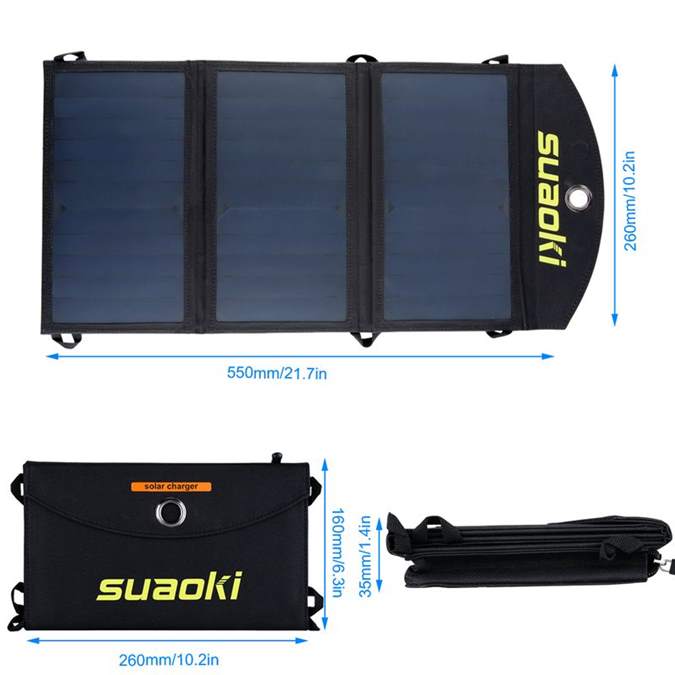
Suaoki foldable solar panel
Price: $65
From: EBay
RATINGS:
How useful is it: ****
Value for money: ****
Ease of use: *****
How well designed is it: ****
Product quality: Good
Our recommendation: No problems at all with this.
There are times when you may be away from your normal charging sources and need to get some power into your phone, camera etc.
While battery banks are useful, they also have to be recharged and so we went looking for something that would recharge just about any
device that could be charged using a USB port.
We wanted something that could be easily carried and had the ability to charge while we were walking.
What we decided on was a Suaoki foldable solar panel that delivers 20 watts of power.
The panel seems well designed with a zip-up pocket that you can put your phone in, two standard USB sockets that are firmly attached to the inside of the pocket
and it came with 4 clips that allow it to be hooked on to just about anything.
The idea is that the panel can be opened and hung from the back of our camera back-pack so we can charge items as we walk around.
So far we have only tested this briefly but found it fully charged our phone (empty to full) in three hours.
We still have a lot more testing to do with this item before we can say much more about it but so far it does the job we hoped it would do.
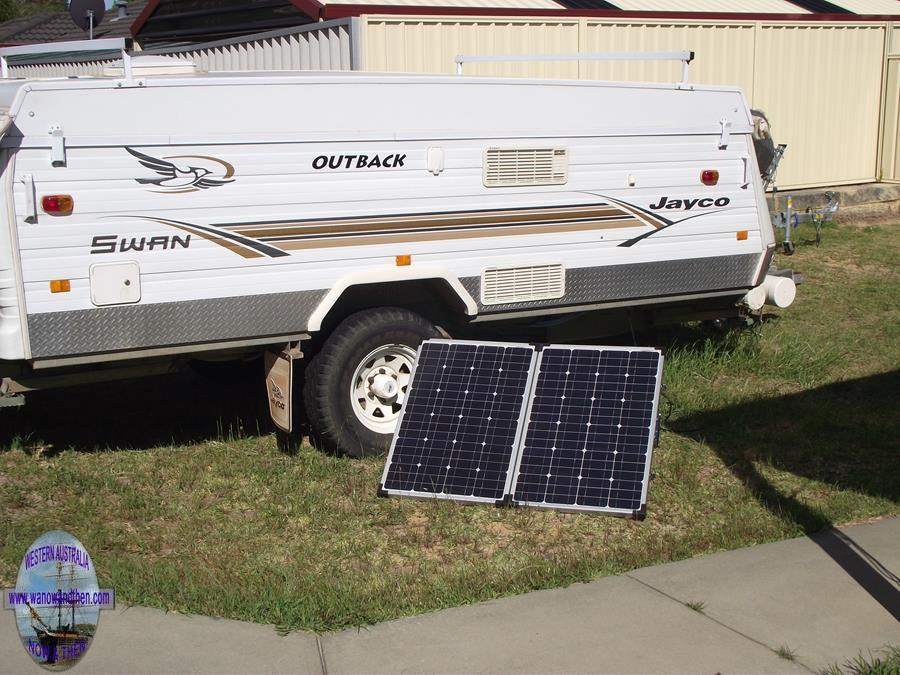
Solar panels folding, shade tolerant and roof mounted.
Price: $varies
From: Specialty dealers
RATINGS:
How useful is it: *****
Value for money: ****
Ease of use: ****
How well designed is it: ****
Product quality: *****
Our recommendation: Highly recommended
Although the picture shows a portable set of 2 x 60w solar panels, this review is more about solar panels in general and the changes we have seen over the years.
Uni-Solar panels were once popular because they are 'shade tolerant' and the 64w panel produces the same power as an 85w. From our observations these claims seem to be largely true.
Compared to the 85-90w panels, the 64w panel IS HUGE so you need more area to mount them.
We have an 85w BP panel that is around 2/3 the size of the Uni-Solar. Uni-Solar panels ARE NOT suited to pull out and move around. Their size and weight demands that they are mounted
on top of a vehicle and forgotten about - almost.
The BIG drawback of Uni-Solar panels is that they MUST BE REGULARLY CLEANED. They DO NOT SELF CLEAN. This is the main reason they are not accredited for use by big organisations
like Telstra. Due to the uneven surface of the panel it is a magnet for dirt and dust and has to be inspected and cleaned at regular intervals to ensure correct operation.
BP panels are basically mono or multi crystalline. Mono being the older looking panels with hexagonal black looking cells and multi crystalline being the blue flecky looking ones. There isn't much
to choose between the different types.
Because of the on-going maintenance associated with our Uni-Solar panel we got rid of it and switched to the more standard style.
Angling panels towards the sun makes a difference to the power they put in but is it really worth the extra effort? We opted to place all panels on the roof for simplicity and security
but we do lose some power because of this.
Recent changes in solar panel design mean that now you can get 200w panels that are cheaper than the old 120w model we bought when we first started using solar.
Our most recent solar panels were 120w (2 x 60w) mounted on a stand to make them portable. While this enables you to park in the shade and put the panels out in the sun, we were just
too worried about the security of the panels and too fed up with moving them each time the sun moved. In the end we even put these panels up on the roof.
We found that the cheap regulators that come attached to these panels are NOT suitable for use with gel-cell or AGM batteries. We have removed them and now run these panels via a better
quality regulator.
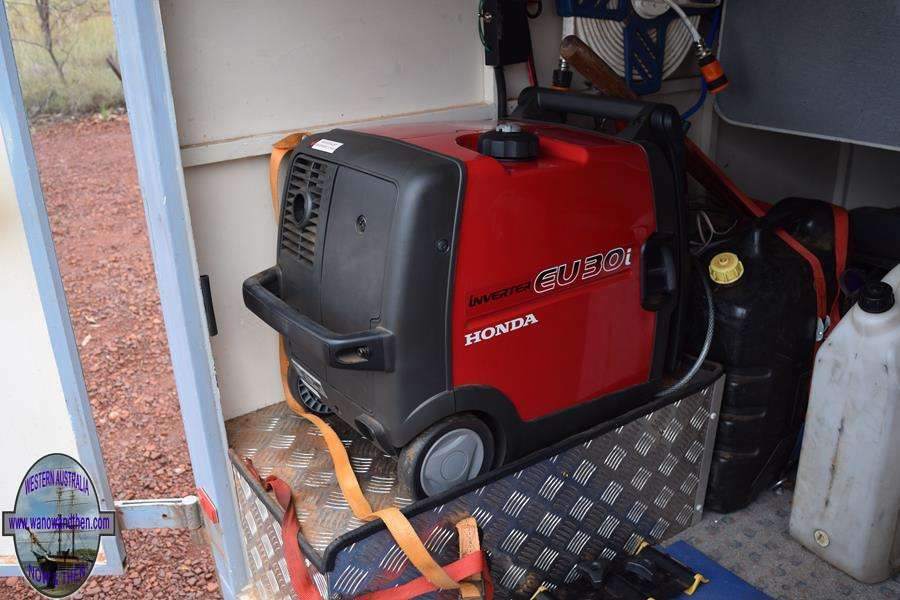
Honda EU 30i generator
Price: $2999
From: Honda Shop Midland
RATINGS:
How useful is it: *****
Value for money: ****
Ease of use: *****
How well designed is it: *****
Product quality: *****
Our recommendation: We love Honda generators and although we mostly use solar now, this is great to have as a backup.
Our old Honda EU20i generator had been working perfectly for many years but when we purchased the Toyota Coaster
we found it did not supply enough power to run the Air-Command Ibis3 air conditioner.
We had no choice but to sell our old generator and buy this higher powered model.
At the time of writing this, we haven't really used it that much but it has been used for both cooling and heating cycles on the air-con.
It is a case of, so-far, so-good.
It isn't a light-weight generator so it is handy to have the wheels and a fold out handle to allow it to be moved around easily.
As time goes by we should have more to say about this generator with regard to ease of servicing etc.
The price we bought it at included a cover, oil and extra spark plug.

Generator (Honda EU20i).
Price: $2150
From: Specialty dealers
RATINGS:
How useful is it: *****
Value for money: ***
Ease of use: ****
How well designed is it: ****
Product quality: *****
Our recommendation: Highly recommended
Not everyone wants to take a generator camping and many people try to rely purely on solar panels and batteries to run their power. We have found that a few cloudy days can put
paid to any solar system and we have lost count of the number of people we have spoken to who have had problems once the sun goes away for a few days.
We started off with a Honda 500w generator and progressed from there to an EM100f (Honda) which was too small when we were travelling in the big bus. This Eu20i model has
plenty of power to spare and is very economical. It is reasonably quiet and produces perfectly clean power as there is a sine wave inverter integrated into it. It usually starts first pull
and will run on a full tank of fuel (4.2 litres) for around 11 hours. (Others we have met who have a similar sized generator with no eco-throttle report that a tank around 4 litres lasts only 7 hours.)
There are many cheap generators around today and you can get 750w models for as low as $98 from Bunnings. They DO NOIT produce clean power and we have seen people hook them up
to expensive items like an Engel fridge, only to have the fridge die almost immediately.
The real cheapies are also 2 stroke motors which are more noisy and tend to pollute more.
We used to rely heavily on the Honda and ran it for around 3-4 hours a day when we are bush camping.
After having our first Honda eu20i for 4 years and running it for well over 2500 hours we decided that it would be a good idea to sell it before anything went wrong and get
a new one. We managed to get $900 for the old one and Honda offered a $200 cash back at the end of the financial year on a new one so we ended up purchasing a brand new eu20i for $1050.
The new model now comes with a 4 year warranty. We do like to see manufacturers showing this sort of confidence in their products.
The only problem we have ever had with one of these generators was the pull rope breaking on one occasion. This was covered by the warranty and fixed at no charge.
Although we are now making much more use of solar power, we still have our trusty old Honda packed in the trailer just in case it is needed. As we recently purchased a Toyota Coaster
with an air-conditioner, I suspect it won't be long before the Honda is brought out of retirement and put back into use again.
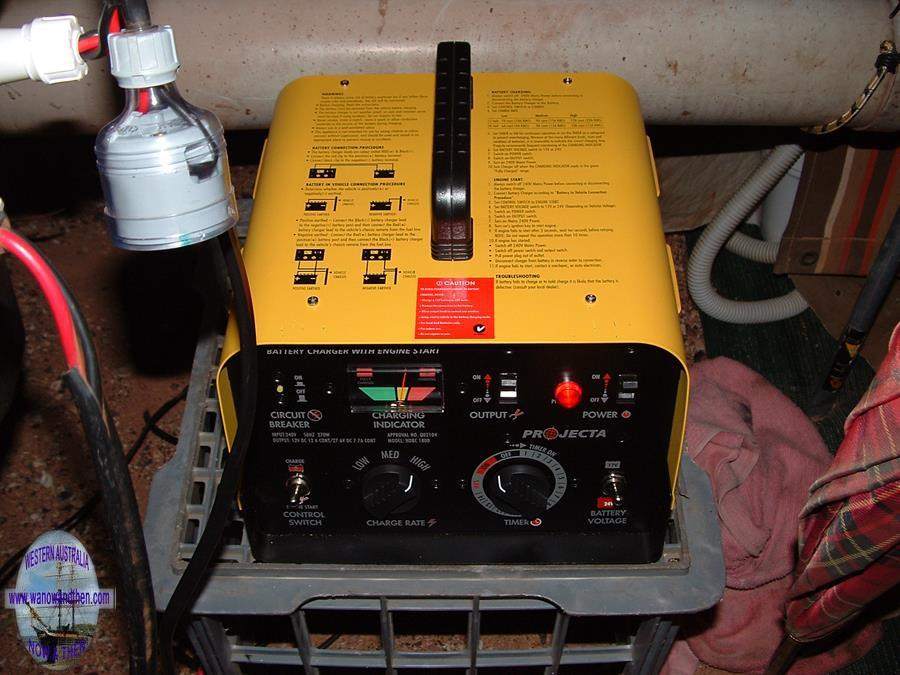
Projecta 12amp (20amp RMS) Battery charger
Price: $279
From: Repco
RATINGS:
How useful is it: *****
Value for money: ***
Ease of use: *****
How well designed is it: ***
Product quality: *****
Our recommendation: Beware when it gets old.
Our solar system was occasionally suffering from a lack of sun so we decided to get another battery charger. With big chargers (50amp etc.) costing so much money we opted for a
12amp continuous (20amp RMS) charger that we saw in Repco.
It will charge both 12 and 24 volt batteries, start a car with a flat battery and includes a timer so you can prevent overcharging. There are three levels of charging and if weight is anything
to go buy, it seems to be well constructed.
Update July 2007: We have been using this unit regularly and apart from one occasion when we accidentally flicked the switch from 12 to 24 volt (and boiled the batteries briefly)
it has been a very useful adjunct to our power system. It is used to top up the batteries when we run the generator at night and in the morning we usually have a reasonable charge
(11.8-12.2v) in the batteries when the fridges are turned back up. It seems to put in between 5-6 amps while our batteries are reasonably charged up and will increase this if they
are less charged.
Update 2011: This unit had worked well for years until it suddenly became dangerous. For some unknown reason the outer metal casing became 'live' and one day when I touched it I
got 240v up may arm. It was promptly discarded and a new unit purchased.
2015 : While this product has been super ceded by the newer battery chargers, there may still be a few in use and we thought it might be good to leave the review here as a warning
about the danger of using these as they get older.
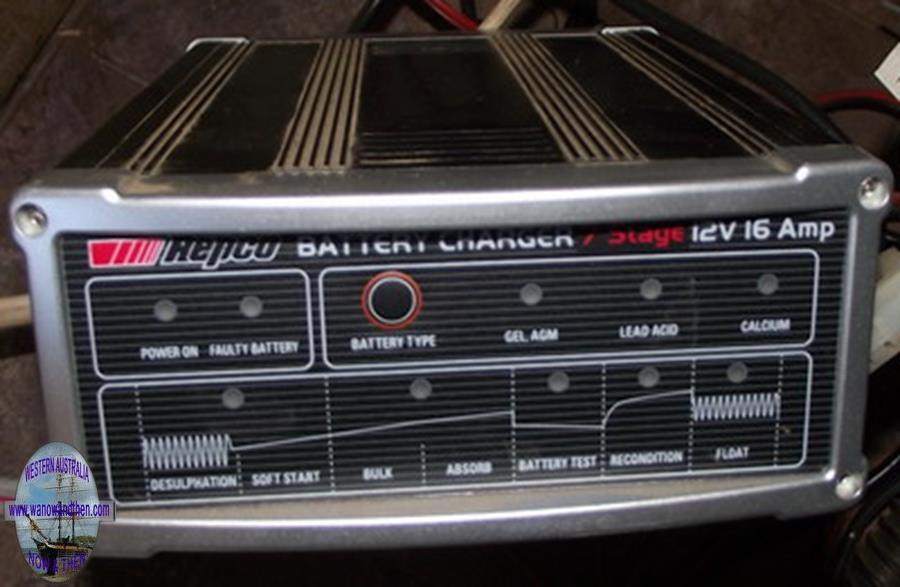
Repco 16amp 12v Battery charger
Price: $279
From: Repco
RATINGS:
How useful is it: *****
Value for money: ****
Ease of use: *****
How well designed is it: ****
Product quality: ****
Our recommendation: Ok to buy
This unit recently replaced the older charger (above) and to date has worked well. The only hassle is that it does not remember which type of battery you have when switched off
and defaults to lead acid. As we have gel cells we have to remember to change this setting every time it gets turned on.
It is a 7 stage charger so it is suitable for all deep cycle applications as well as for starter batteries. We have made extensive use of this 16 amp model and have been happy enough
with it that we have purchased an 8 amp model for the car.
2015 : Still using both the 16 amp and 8 amp chargers and still happy with both products.
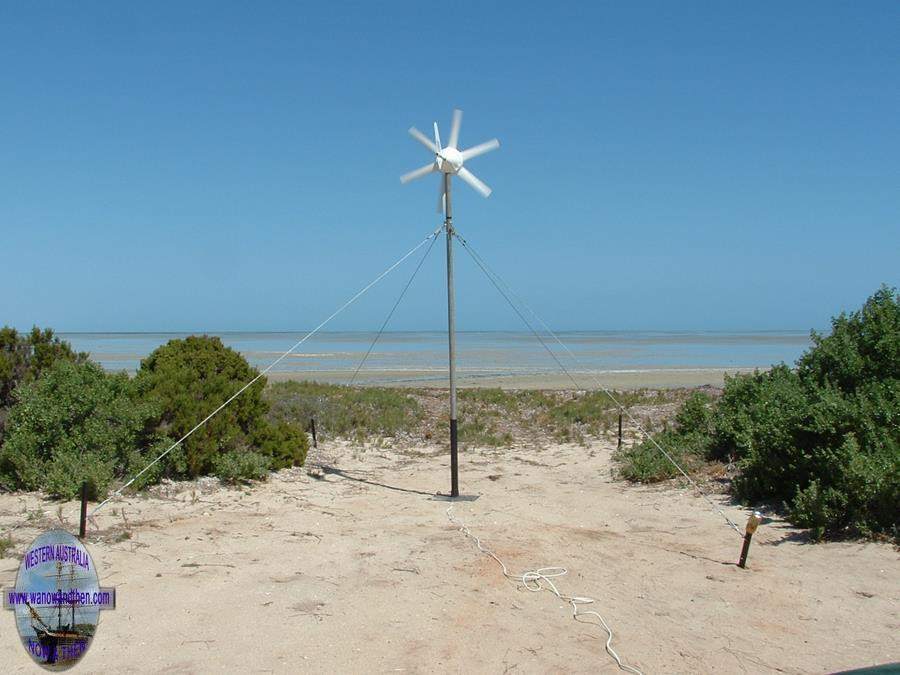
Rutland 913 Wind Generator
Price: $1800 including mounting
From: Outback Marine
RATINGS:
How useful is it: ****
Value for money: **
Ease of use: **
How well designed is it: ****
Product quality: *****
Available in 12 or 24 volt models
Our recommendation: Think twice before you buy any wind generator
We purchased a wind gen in order to try and do away with using the petrol generator at night. We had to make the mounting up ourselves as they are not available from the supplier.
The mounting cost around $220 for all the bits and pieces.
Wind generators need to be set up high, away from your vehicles and need to be mounted on a strong metal pole with wire cables running down to the ground to stabilise it.
The big problem with this is that you need to be staying in one place for an extended time to make it worth while putting up. It really isn't a good idea for those people travelling from
place to place all the time. The wind generators are quite high tech and they sense the state of charge of the batteries or they use a separate regulator. One model (the Air X)
shuts down when the batteries are charged and starts again when required. This is an expensive item and will only be useful to people intending to camp in one place for several weeks
or months.
One thing we can immediately comment on is the noise level of the Rutland as opposed to other wind gens we have seen. The Rutland is amazingly quiet and even in the ferocious winds
of Bush Bay. I can hear nothing from the wind gen which is a mere 10 metres away. Other 3 bladed wind generators are quite unpopular (with other campers) as they a very noisy.
Parts needed for a stand:
1 galvanized or aluminium pole greater than 8 feet high. (the higher the better).
4 x 5mm steel cables (length depends on the height of the pole.)
8 x 5mm cable clamps
4 x 5mm hook and eye turn buckles
8 x 5mm U bolts
4 x 5mm stainless steel D saddles
8 x appropriately sized rivets to attach the D saddles to the pole
1 base plate with holes for tent pegs
4 x tent pegs
4 x star pickets
1 x larger diameter pole segment to slip the main pole in for stability. (this needs to be attached to the base plate and only needs to be a couple of inches high.)
Update May 2008: While we were happy with this unit when it was being used at Bush Bay (a VERY windy area) we are less than happy with its performance while it has been in use
at Karratha. We are also concerned that it seems to put out only half the Amps it is supposed to and that our numerous enquiries to the manufacturer (Marlec in England) have been
completely ignored. We are also worried about a strange vibration the wind gen develops in wind speeds of around 40 kph.
In the very highest winds we have been in (40 plus knots) the wind gen has only managed to generate 9 amps. During light winds we are lucky to get 1-2 amps. We are starting to
think that a couple of new solar panels would have been a better investment.
A comparison in varying winds:
The Rutland 913 is about the equivalent of 1 x 120 watt solar panel in light to moderate winds that blow for at least 12 hours a day. It is about equivalent to 2 x 120 watt solar panels if it is in
light to moderate winds for 24 hours a day or in strong winds for 12 hours. If the winds are strong and continue for 24 hours then the 913 is about equivalent to between 3 and 4 x 120 watt
solar panels.
Light to moderate = 10 to 20 knots
Strong = 20 to 30 knots or above.
Note: This wind generator may overheat in very strong continuous winds and to cool itself down it will stop generating power and start to free-wheel. When it does this it sounds like an aero
plane taking off - don't panic it is normal. The best thing to do if it continues to do this in strong winds is turn the blades out of the wind and then tie the unit up so that it does not operate.
This is the only time that the Rutland is noisy.
You also need to be aware that if you want to work on your batteries and want to disconnect the regulator you MUST close the wind gen down first by tying it up and then disconnect it from
the regulator BEFORE you disconnect the regulator from the batteries.
Update October 2009: This unit was only a month out of warranty when we had a problem develop. For some reason it stopped producing power and on investigating inside I found one
of the brushes had stuck and jammed. I had to order a new set (costing around $30 including postage) and when I installed them I found a dramatic improvement in the power that the
unit was generating. It now regularly supplies 4-5 amps instead of 1-2 amps in similar winds.
2012 : We have retired the wind gen from use on the road and it now stands beside our garden shed providing power for a battery system in the shed to give lighting, power and 12 volt
fan operation. We have no need to connect the shed to mains power.
2015 : The wind gen is still going strong, still quiet while spinning and still giving free power. In its current position it is in the best place for it to be useful.
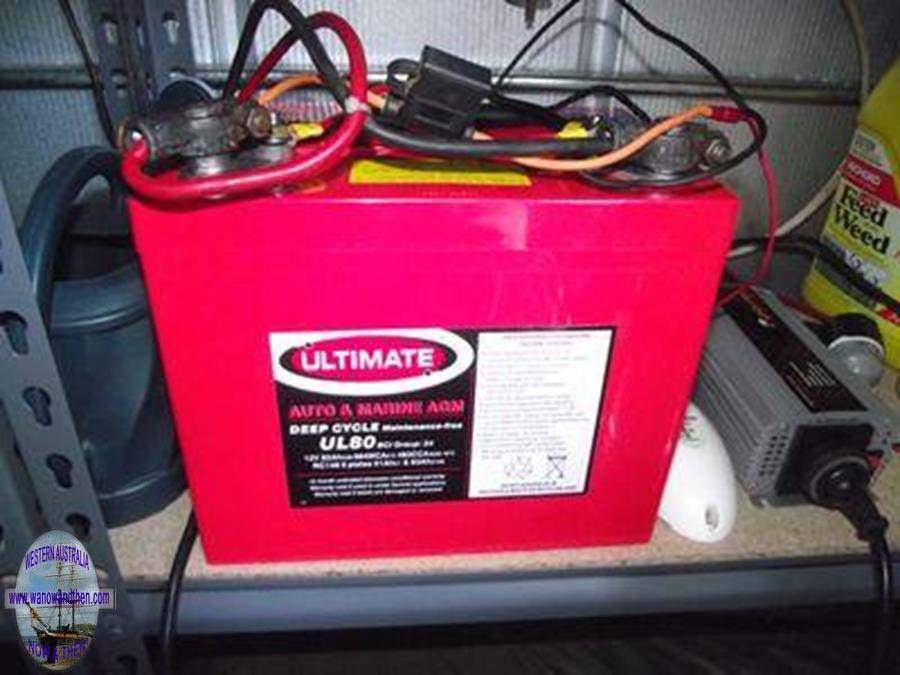
Ultimate Deep Cycle AGM Battery 80ah
Price: $352
From: Battery World
RATINGS:
How useful is it: *****
Value for money: ***
Ease of use: *****
How well designed is it: *****
Product quality: ****
Our recommendation: Ok to buy.
This was our first AGM (absorbed glass mat) battery. We have tried lead acid and then moved on to gel cell (which we used for our main battery bank for about 5 years)
but now we have switched to AGM for all our 'house' battery needs.
This is an American made battery, hence the price I guess, and we are hoping that it will have a long life. We did end up buying a larger version of this batter (105 amp hours)
for use in the caravan and both batteries have worked well and are still going strong after 3 and 2 years respectively.
This battery has both bolt on connections and standard car connections. It can be mounted inside and does not have to be upright so it has the same characteristics as a gel cell.
The idle discharge rate of this type of battery is said to be much less than a flooded lead acid battery. They are also supposed to be faster to charge than lead acid batteries. As
with gels cells, AGMs should not be charged in the same bank as lead acid batteries.
The smaller of the two has been used in the boat to power the echo sounder, radio etc and the larger one has been used in the caravan as a 'spare' just in case our main battery bank
ever ran down too far.
In the past we attempted to use motorcycle batteries in the boat (trying to save money) but that was a dismal failure.
We have recently had to replace our old North Star gel-cell batteries (that lasted about 6 years) and have now started using BOSCH AGM batteries for our main 'house' battery bank.
It is too early to comment on these yet but we will put up a review when we have been using them for 2-3 years.
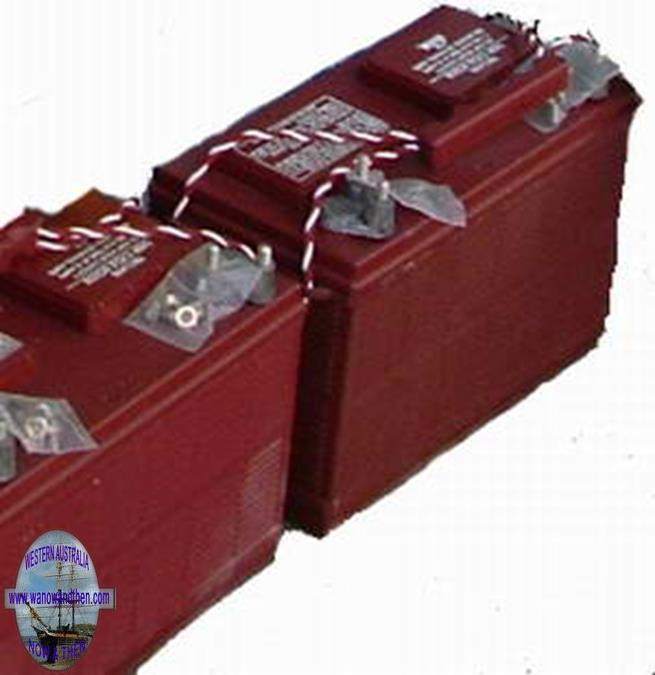
Deep Cycle Batteries (Trojan 130ah)
Price: $205
From: Marshall Batteries / Barry Edwards Solar
RATINGS:
How useful is it: *****
Value for money: ***
Ease of use: *****
How well designed is it: *****
Product quality: *****
Our recommendation: Buy AGM or gell cell batteries instead.
We first purchased these in late 2005 and the first one failed in September 2009.
To start with these deep cycles have two positive and two negative terminals, each with its own wing nut. This is exactly what is required on a deep cycle battery.
Too many manufacturers still seem to think of deep cycles in terms of starter batteries and put normal car terminals on them. Deep cycles (or house batteries as
they are often referred to) are not for starting a car, they are for running 12 volt appliances in a caravan or motorhome and as such they need a system to allow
people to easily remove cables and add cables when required.
You can clearly see the dual post connections in the photo above that allow simple attachment to the battery. We have chosen to use Trojan batteries as we have
been told that they are better quality than most others and having used other brands in the past we have found that battery life has been limited to 2-3 years. It turned
out that the first Trojan failed after 4 years fairly heavy use.
We have made the mistake (in the past) of buying different brand and different amp hour rated deep cycles and using them in the same bank. This time we bit the bullet
and spent around $600 to get 3 batteries all the same make and amp hour rating. We this turned out to be the right decision.
One note that needs to be made about these batteries is that they are higher than normal starter batteries and we did have trouble putting one in the Landcruiser as a second
battery as the bonnet would not close. Some quick panel work with a BIG hammer was required to make it fit.
The real problems with the old fashioned led acid batteries is that they require continual maintenance, need to be mounted upright in a ventilated area and produce dangerous
flammable gasses. For this reason we no longer recommend this style of battery.
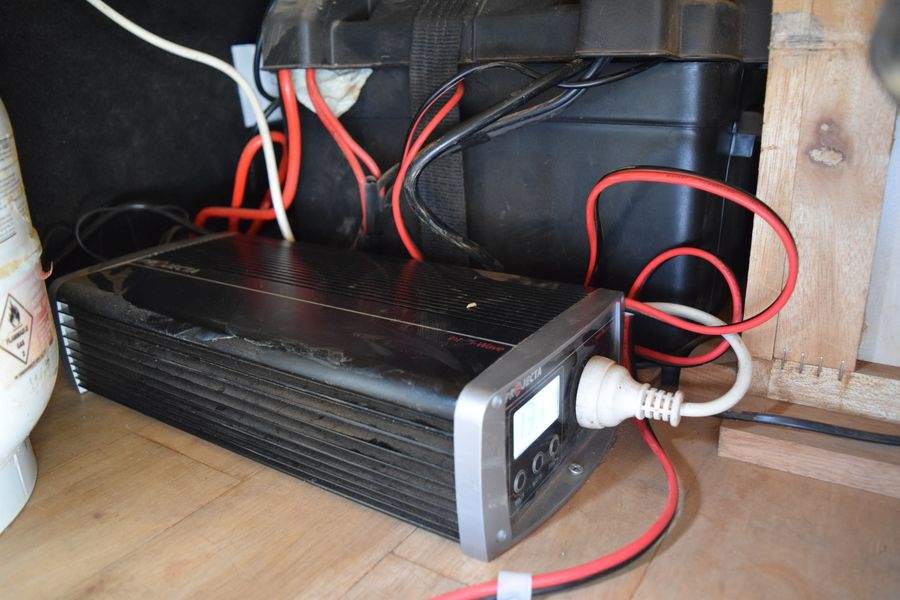
Projecta 1000w PSW inverter
Price: $? Can't remember
From: Auto store
RATINGS:
How useful is it: *****
Value for money: ****
Ease of use: *****
How well designed is it: *****
Product quality: *****
Our recommendation: This is the main inverter we have in the Coaster currently and has been good so far.
We have a few different power needs in the Coaster ranging from simple things like recharging batteries to running a washing machine and TV plus computers.
This model has a remote on/off switch with LED display. This has been very useful as the inverter is placed inside the rear compartment while
the wired remote is inside where it can easily be accessed.
Projecta aren't eaxactly top quality products but this has been great so far and that is quite a few years now.
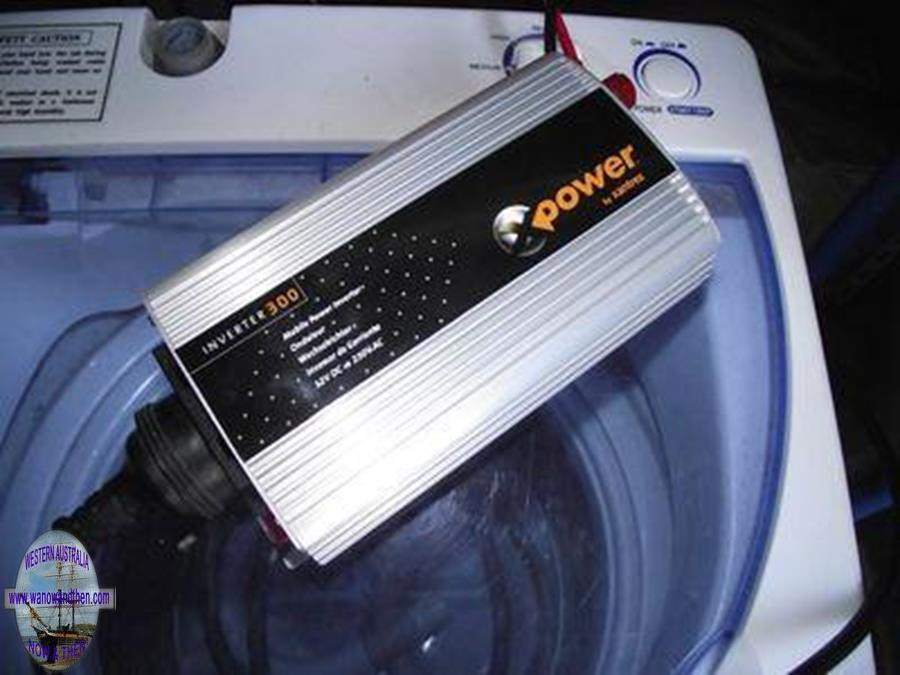
X Power 300w MSW inverter.
Price: $129
From: BCF
RATINGS:
How useful is it: ***
Value for money: ****
Ease of use: *****
How well designed is it: *****
Product quality: ****
Our recommendation: Ok to buy but pure sine wave inverters are better.
We wanted a simple inverter for use in our 'green' wind-gen powered garden shed. It would also be a handy portable inverter to put in the 4x4 when we head off
somewhere without the caravan.
Its intended function was to run the shed light and give enough power to run basic electrical tools like a power drill, sander, jigsaw etc. It just manages
to do these things but is a little under-powered.
It has overload and overheat protection as well as a low battery (10.7v) shut off. Continuous AC power is 300w and peak power for surge is rated as 600w.
Battery drain of the inverter alone
is said to be .2 of an amp.
The inverter comes with 12awg wire and has both clip connections and cigarette lighter connection included. No inverter should be connected to a cigarette
lighter in a car if loads of greater than 150w are expected. It is much safer to direct wire inverters to a battery (and include a fuse) if loads will be
above 150w.
We would not normally recommend a MSW (modified square wave) inverter for use in motorhomes and caravans and we would suggest a minimum of 600w for use in
those areas. This is for a small, limited application and manages to do what we want it to.
It was sold before it decided to die so I have no real idea how long it lasted.
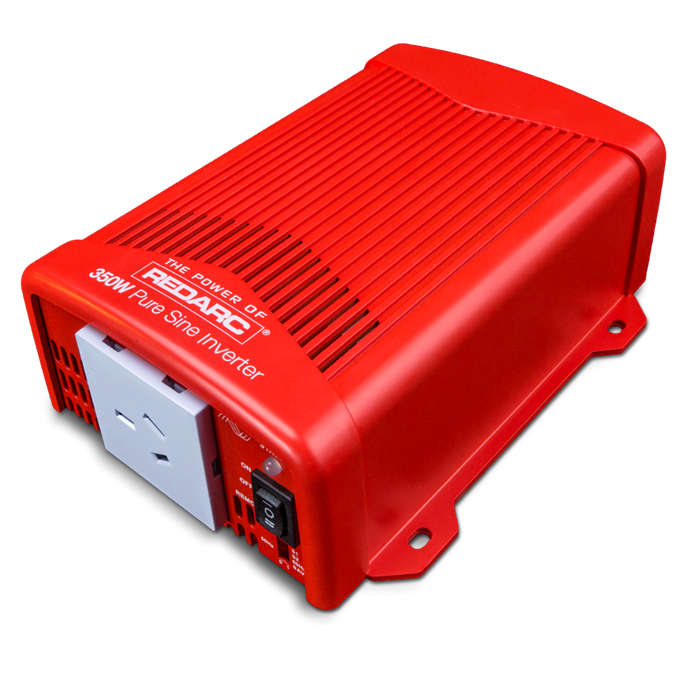
Redarc 350w sine wave inverter.
Price: $400
From: Specialty stores.
RATINGS:
How useful is it: ****
Value for money: ****
Ease of use: *****
How well designed is it: ****
Product quality: *****
Our recommendation: Ok to buy but expensive.
I really only bought a Redarc because I was in Margaret River and needed an inverter quickly. This was the only one I could find
at the time and it was a lot more than I have paid for inverters in the past.
It was been working well for several years now and provides nice clean pure sine wave power.
Most inverters I have owned have eventually given up and died so I guess it remains to be seen how long this one lasts compared to
the cheaper ones I have owned.
Initially we used it in the Coaster trailer, then the camper trailer and now it is permenantly mounted in the 4x4.
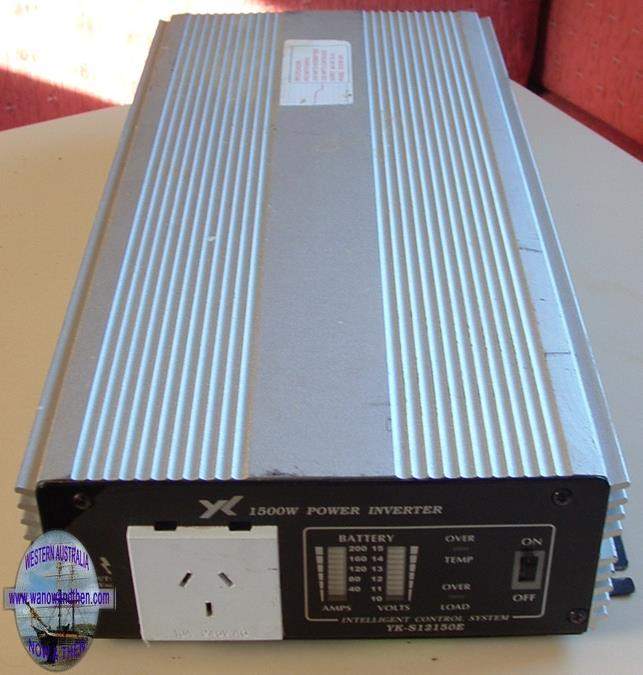
Inverter 1500w (MSW).
Price: $800
From: Specialty dealers
RATINGS:
How useful is it: *****
Value for money: ***
Ease of use: *****
How well designed is it: ****
Product quality: ****
Our recommendation: Ok to buy but think about getting a sine wave model instead.
This is the second modified square wave inverter we have owned. The first died after about 3 years and in the end this one lasted about 4 years.
Inverters are VERY useful if you have sufficient solar panels and batteries to get and store the power you need. Typically inverters like this draw 0.5-1.5amps and there is a 10-20% loss
of power. What this means in reality is that you need enough solar panels to get your big batteries charged up and enough big batteries to handle the demand from the inverter.
We have been told of modified square wave inverters causing problems with variable speed motors and electronic gear like laptop computers. So far we haven't experienced any problems
with this model but we can't make a blanket statement that no-one will have problems if they choose to use one of this style.
Sine wave inverters used to be VERY expensive and this led to us using MSW inverters for a long time. These days pure sine wave inverters are much cheaper and are therefore
a better option when you are considering which type to buy.
We chose a large inverter (1500w) because we have used it in the past to run a 240v house fridge (17amp draw once started) and high wattage is needed to get the compressor started.
We have operated the following on the inverter with no signs of a problem (yet), Washing machine, Laptop computer, TV, Video, DVD, Stereo, Domestic fridge, Lights, Fan.
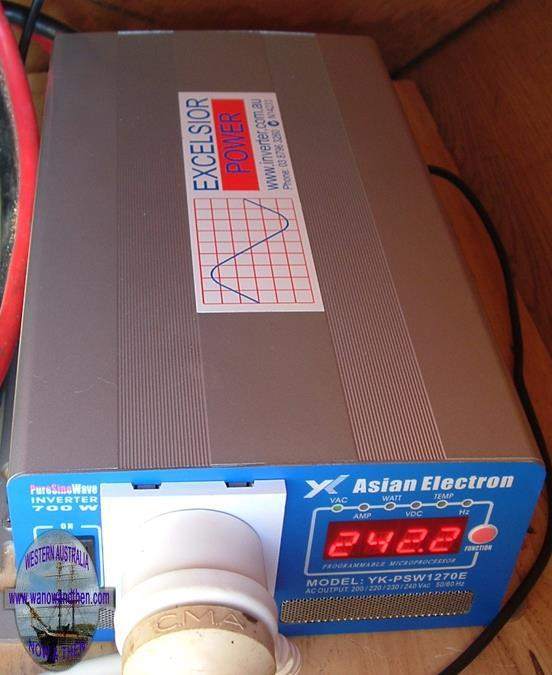
Sine wave inverter 700w Asian Electronics.
Price: $710 delivered
From: Specialty dealers
RATINGS:
How useful is it: *****
Value for money: ***
Ease of use: *****
How well designed is it: ****
Product quality: *****
Our recommendation: Ok to buy
This is the first pure sine wave inverter we have purchased and as it lasted for about 5 years.
One thing I can say is that I was crazy for purchasing MSW inverters because with this we could use any electrical appliance without wondering if it will fry itself the minute
we turned it on. Although the old inverter (shown above) was able to run most of the appliances we wanted to use, there was always the fear of having something expire
the minute you turned to power on for the first time.
At just 700 watts this inverter won't run everything but it was big enough to run the computer as well as the TV, Video, DVD and satellite decoder all at the same time.
It will also run the Lemair washing machine but we tend to keep other appliances off when we are doing the washing.
We restrict use of the inverter to the hours 9am-3pm to ensure we get maximum benefit from the solar system. On the odd occasion when we want to watch a program late at
night and can't run the generator in case we disturb other campers, this inverter comes in very handy as well.
(Note: When we use our wind generator in very windy areas we are able to use this inverter on a 24 hour basis and never need to run the petrol generator for 240v applications.)
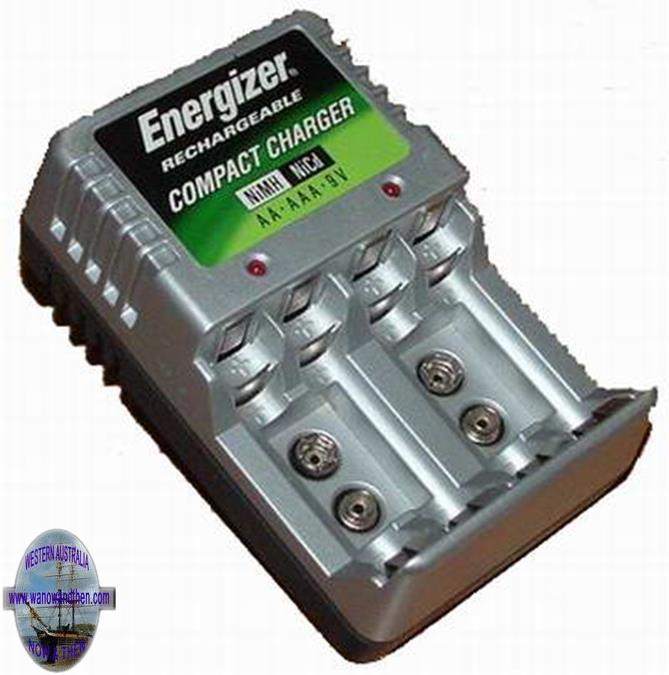
Battery Charger for AA and AAA batteries.
Price: $30
From: Supermarkets
RATINGS:
How useful is it: ****
Value for money: ****
Ease of use: ****
How well designed is it: ****
Product quality: *****
Our recommendation: Highly recommended
Because we make use of AA and AAA batteries all the time we finally decided to get some NiMH batteries and a charger to try and save money. To date we have made great use of this for our
camera, GPS, torches and walkie talkies and it has paid for itself very quickly. It needs 240v power to recharge and that is taken care of by either the Honda (above) or our sine wave inverter.
(We do not recommend using battery chargers with modified square wave inverters.)
As for the batteries we have used to re-charge. Energizer are good, Sanyo Eneloop are good, Eveready are rubbish. Any cheapie brand is rubbish. You pay for what you get. Expect 2 years
more or less continuous usage before the better quality batteries need replacing.
Although the picture shows an Energizer charger, we have found they are all pretty much the same quality and price. We have 4 chargers in totalt but the best by far is the oldest model
that does not seem to be available any more. Why do I mention it? Because they can sometimes be found in second-hand stores (which is where we found ours) and if you see one GRAB IT!
It is GN deluxe universal battery charger and tester. Yes, it tests batteries too! This is such a useful gadget it is a shame they don't seem to be produced any more. They will charge
rechargeable AA, AAA 9 volt, D cell and a few other types.
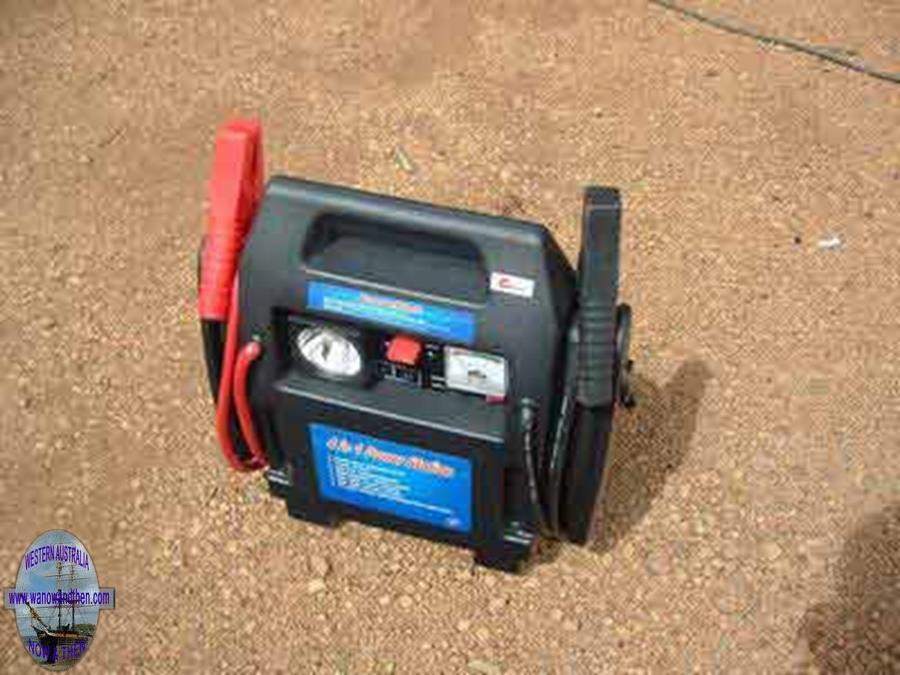
Power Pack / Compressor .
Price: $79
From: Bunnings camping stores, Repco etc.
RATINGS:
How useful is it: *****
Value for money: ***
Ease of use: *****
How well designed is it: *****
Product quality: *
Our recommendation: Do not buy cheap 'made in China' versions.
This is the second of these power pack units we have purchased. The first was an American unit that did not include a compressor. It eventually died due to electronic component corrosion after about
5 years but we were still able to use the internal battery for some time afterwards.
The model pictured above is Made in China. It includes a compressor and a power meter and is quite a good deal heavier than the American unit we had. The initial unit cost $135 and lasted a long time.
These type of units are very useful and can be combined with a small 150w inverter (see above) to give you easy to access 240v power.
This cheapie didn't last anywhere near as long as the more expensive American version. Next time I need one of these I will go back the a quality version and not waste money on a cheap Made in China product.
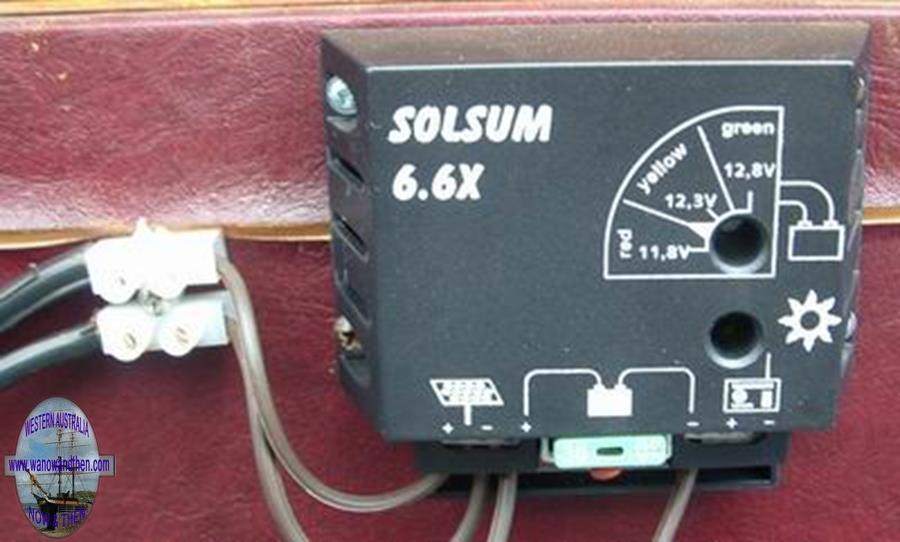
Solar Regulator 6 amp
Price: $49
From: Barry Edwards Ph. 08 9336 2414
RATINGS:
How useful is it: *****
Value for money: *****
Ease of use: ****
How well designed is it: **
Product quality: ***
Our recommendation: Get at least a 20 amp model to allow for expansion
The big complaint I have with these units is that the terminals for the wires accept only 3-4mm wire and you have to put in a joiner (see picture above) to attach the 6mm wire you need when using
12v systems. his seems to be a basic design flaw that could have easily been avoided.
The other problem is that these units have been blowing fuses even though they are only accepting power from a panel that produces less than 6 amps max. I got fed up with this and put in a bigger fuse.
This of course led to the early demise of the regulator but in the end it was worth getting rid of it and buying a decent quality model.
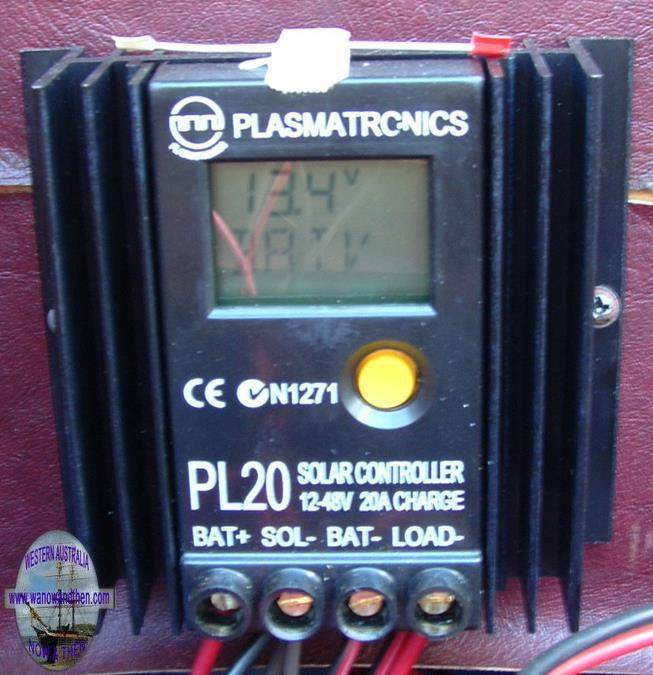
Solar Regulator Plasmatronics PL 20
Price: $298
From: Specialist solar stores.
RATINGS:
How useful is it: *****
Value for money: ****
Ease of use: ****
How well designed is it: ****
Product quality: *****
Our recommendation: Highly recommended
Plasmatronics have a good reputation in the solar world and we have seen plenty of these units in use and have yet to hear a single complaint about them. As I managed to destroy the
Solsum regulator and needed one that would take up to 20 amps, the PL 20 seemed the best option.
The Plasmatronics is a little more sophisticated than is really necessary as it maintains a history of solar use over a period of 30 days. The statistics available from these units are quite
comprehensive and include: State of charge in %, Amp hours in, Amp hours out, Maximum voltage reached, Time charging ended, Current charge in Amps, Current load in Amps and
Current voltage.
The charging cycle includes boost, equalisation, absorption and float. The unit has a low battery disconnect option (11.2 volts) and can be set to send current to the load automatically
once charging has finished for the day.
Although it may be a little more complicated to operate than other regulators, the information it provides means that it can be used by people requiring a sophisticated monitoring system,
or by people wanting just a good reliable unit to keep their solar system working.
In the end I sold this unit with our big caravan and ever since I have regretted that decision.
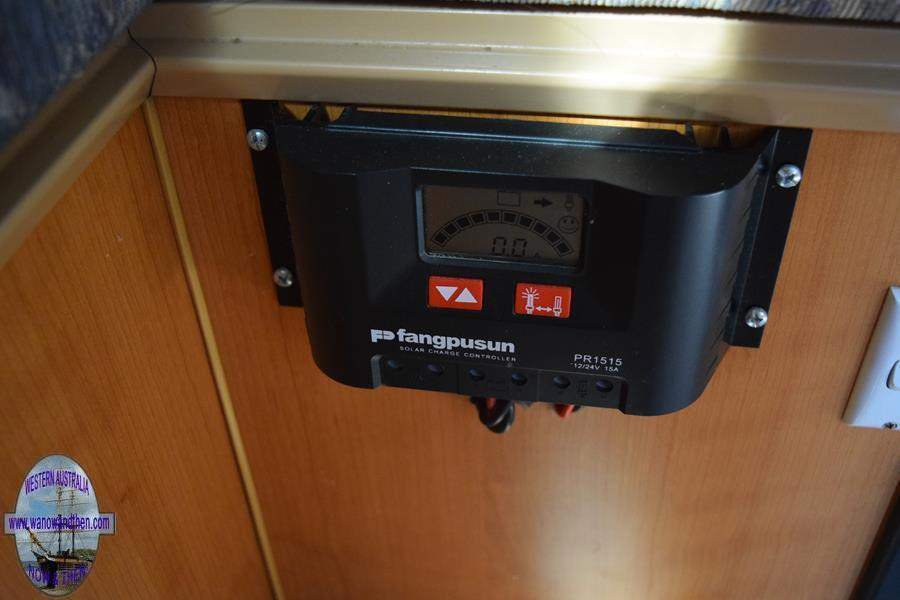
Fangpusun 15 amp regulator
Price: $85
From: Caravan parts suppliers
RATINGS:
How useful is it: *****
Value for money: *****
Ease of use: *****
How well designed is it: *****
Product quality: ****
Our recommendation: Ok to buy.
Purchased based on price more than anything else this model will handle lead acid, gel cell and AGM batteries. It has very simple to use controls, is easy to install and has a useful easy to read display.
We have been using it for quite some time but I have never been quite happy with the readings it gives when it comes to % state of battery charge. I really should have bought this, put it in the old
van and held on to the Plasmatronics regulator.
One note; install as per the instructions keeping the panels disconnected and connecting the battery negative lead first otherwise it won't work.

Jaycar 12 volt power box
Price: $100
From: Jaycar
RATINGS:
How useful is it: *****
Value for money: ***
Ease of use: *****
How well designed is it: ****
Product quality: *****
Our recommendation: Buy cheaper than we did.
This cost me far more than it should have and was a result of an impulse buy rather than my ususal shopping around.
I paid around $100 for it from Jaycar and I could have kicked myself because they were available in other places for around half that much.
It does have a good heavy duty handle that makes it easy to move and all the usual connections such as cigarette lighter power,
two 5v USB power sockets, 2 Anderson plug connections, wing nut connections, volt meter and and on/off switch.
It is simple and effective and works well for the second house battery in the 4x4.
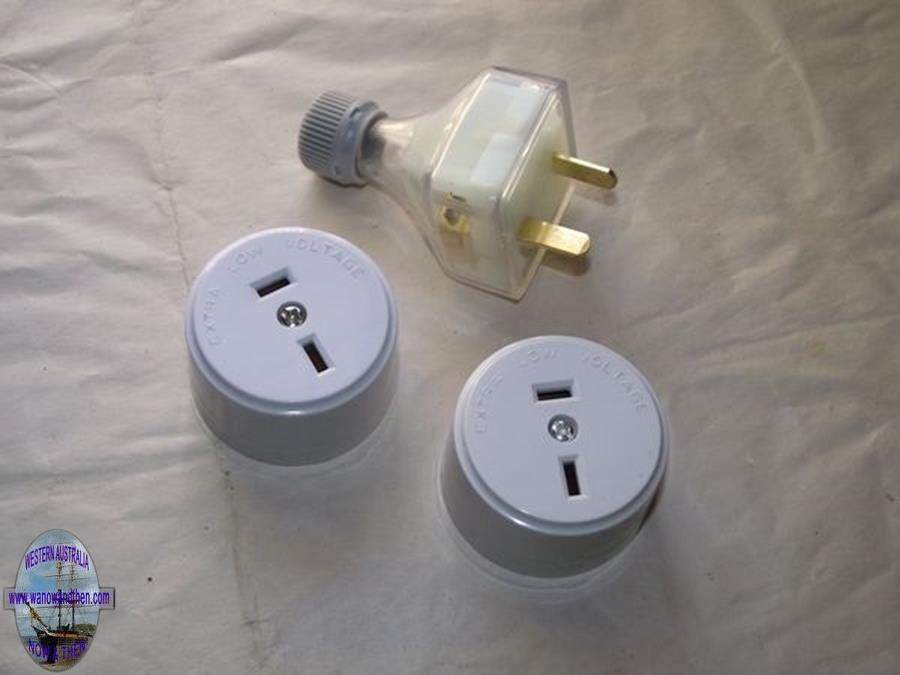
Low voltage plugs
Price: $varies
From: Caravan parts suppliers
RATINGS:
How useful is it: *****
Value for money: *****
Ease of use: *****
How well designed is it: *****
Product quality: ****
Our recommendation: Get these for your 12 volt system.
If you are installing 12 volt appliances then you should be using dedicated low voltage plugs. Why? Because using 240 volt plugs can lead to unfortunate mistakes and
using cigarette lighter plugs is a bad idea as they are generally not good quality and use wiring that is too light.
I don't know if there is a standard way of wiring these up but I have always wired the positive leads to the horizontal pin and the negative leads to the vertical pin. Polarity can be
critical in some appliances so if you want to use one of your gadgets in someone else's system, make sure it is wired up the same way.
If you use these plugs on ALL your 12 volt appliances in your van and 4x4 you will never again be caught out with the wrong connection. It costs a bit of money to
wire everything up because the plugs aren't cheap, but they are reliable and in the end you will be glad you did it.
Cost of the plugs varies quite a bit but the best source we have found for them online is Caravans Plus.
